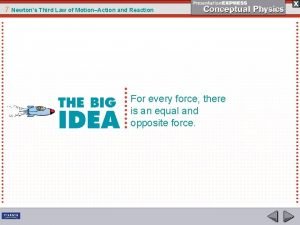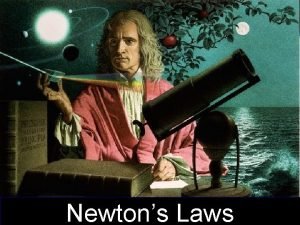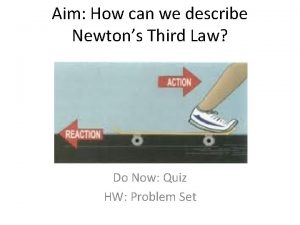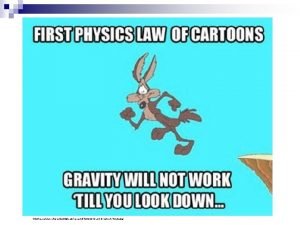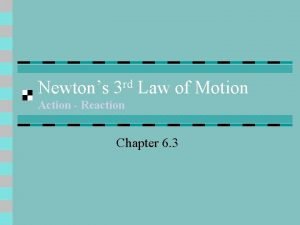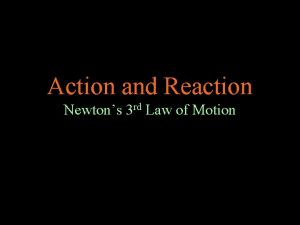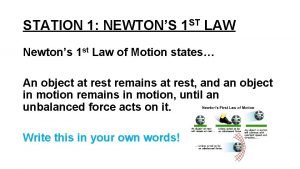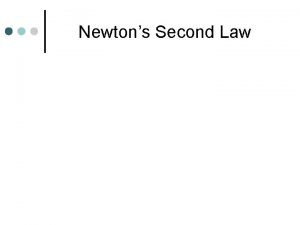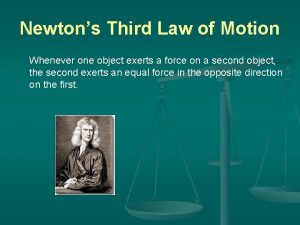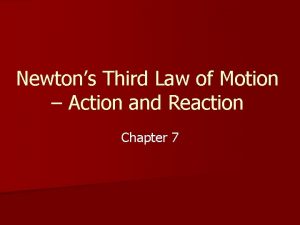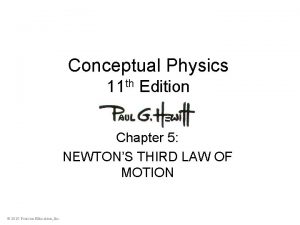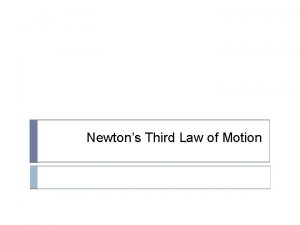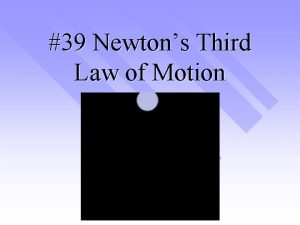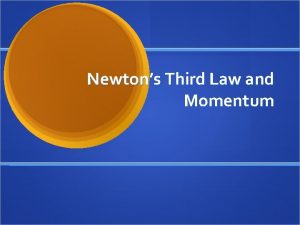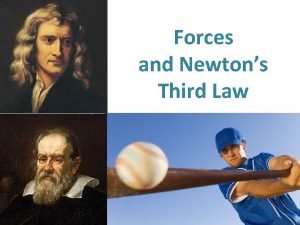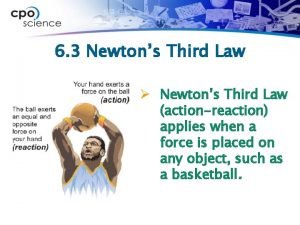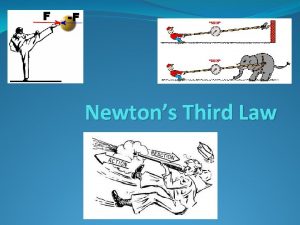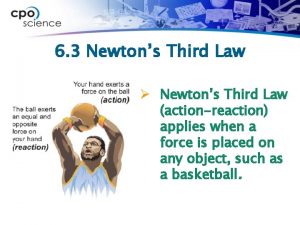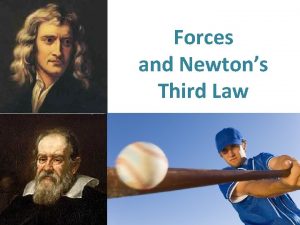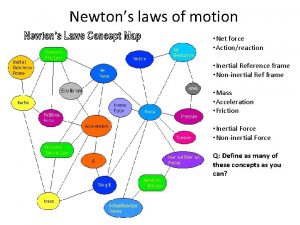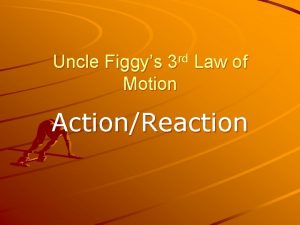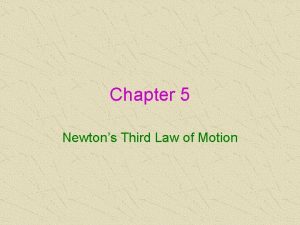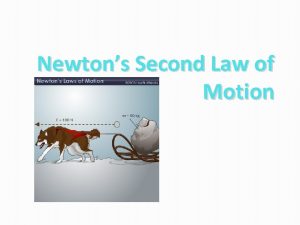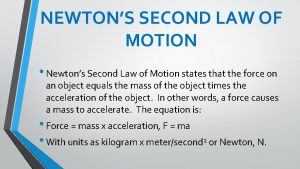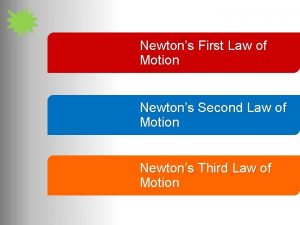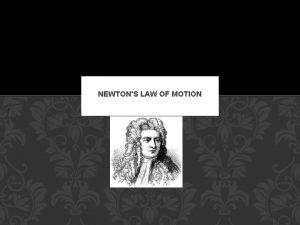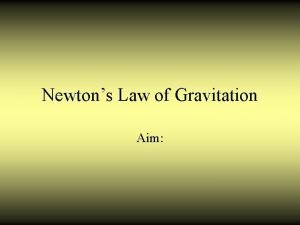Newtons Third of Motion Newtons Third Law ActionReaction
























- Slides: 24

Newton’s Third of Motion

Newton’s Third Law • Action-Reaction • Whenever one body exerts a force on a second body… • …the second body exerts an equal and opposite force on the first body. • Figure 5. 7

Newton’s 3 rd law of motion • Source of force - other objects • 3 rd law - relates forces between objects • “Whenever two objects interact, the force exerted on one object is equal in size and opposite in direction to the force exerted on the other object. ”

• You push on an box sitting on the floor horizontally with a force of 15 Newtons and the box does not move. The force of friction on the box is – A) 0 Newtons – B) 15 Newtons in the direction of your push – C) 15 Newtons opposite to your push – D) less that 15 Newtons.

Questions from Page 78 and 80 • We know that the Earth pulls on the moon. Does this mean that the moon also pulls on the Earth? – A. Yes – B. No

Question • An archer shoots an arrow. Consider the action force to be the bowstring against the arrow. The reaction force is the… – (a) weight of the arrow. – (b) air resistance against the bow. – (c) friction of the ground against the archer’s feet – (d) grip of the archer’s had on the bow – (e) arrow’s push against the bowstring.

Questions from Page 78 and 80 • A high speed bus and a bug have a head-on collision. • The force of impact splatters the bug. – Is the corresponding force that the bug exerts against the windshield greater, less, or the same?

Questions from Page 78 and 80 • A high speed bus and a bug have a head-on collision. • The force of impact splatters the bug. – Is the corresponding force that the bug exerts against the windshield greater, less, or the same? • • • A. Greater B. Less C. Same D. It depends on the speed of impact. E. All of these

Definitions • Vector quantity - a quantity that has both magnitude and direction • Vector - an arrow drawn to scale used to represent a vector quantity • Scalar quantity - a quantity that has magnitude but not direction

Vector or Scalar? • • • Speed………. . Velocity……. . . Acceleration. . Time…………. Distance……. . Force………… scalar vector

The Components of a Vector Even though you know how far and in which direction the library is, you may not be able to walk there in a straight line:

The Components of a Vector Can resolve vector into perpendicular components using a two-dimensional coordinate system:

The Components of a Vector Length, angle, and components can be calculated from each other using trigonometry:

The Components of a Vector Signs of vector components:

Addition of Vectors • The sum of two or more vectors is called their resultant. • To find the resultant of two vectors that are at angles to each other, we use the tip-to-tail method.

Adding and Subtracting Vectors Adding vectors graphically: Place the tail of the second at the head of the first. The sum points from the tail of the first to the head of the last.

Adding and Subtracting Vectors Adding Vectors Using Components: 1. Find the components of each vector to be added. 2. Add the x- and y-components separately. 3. Find the resultant vector.

Adding and Subtracting Vectors

Adding and Subtracting Vectors: The negative of a vector is a vector of the same magnitude pointing in the opposite direction. Here, D = A – B.

Position, Displacement, Velocity, and Acceleration Vectors Position vector r points from the origin to the location in question. The displacement vector Δr points from the original position to the final position.

Relative Motion The speed of the passenger with respect to the ground depends on the relative directions of the passenger’s and train’s speeds:

Relative Motion This also works in two dimensions:

Motion is Relative • Suppose that an airplane is traveling North at 120 km/h relative to the air. • (a) If the wind is blowing 20 km/h toward the North, how fast will the plane travel relative to the ground? • (b) What if the wind is blowing South? • (c) East?

• Consider a boat that normally travels 10 km/h in still water. • If the boat travels in a river that flows also at a rate of 10 km/h, what will it velocity relative to the shore when it heads directly upstream? • When it heads directly downstream? • When it heads across the river?
 Newtons third law of motion
Newtons third law of motion Newtons third law
Newtons third law Newtons third law of motion
Newtons third law of motion Cosa afferma la legge di gravitazione universale
Cosa afferma la legge di gravitazione universale Newton's first law and second law and third law
Newton's first law and second law and third law Newton's first law
Newton's first law Describe newtons third law
Describe newtons third law Newton's third law of thermodynamics
Newton's third law of thermodynamics Equal and opposite reaction
Equal and opposite reaction Newtons 3 rd law of motion
Newtons 3 rd law of motion Newtons 3 rd law of motion
Newtons 3 rd law of motion Newtons 3 rd law of motion
Newtons 3 rd law of motion Newtons first law of motion meme
Newtons first law of motion meme Newtons 3 rd law of motion
Newtons 3 rd law of motion Newtons 3 laws
Newtons 3 laws Newtons 3 rd law of motion
Newtons 3 rd law of motion 1st law of motion
1st law of motion 2nd law of motion
2nd law of motion 2 examples of newton's second law
2 examples of newton's second law Brainpop newton's laws of motion worksheet answer key
Brainpop newton's laws of motion worksheet answer key Newton's first law
Newton's first law According to the third law of motion action and reaction
According to the third law of motion action and reaction Iolab application
Iolab application First law of motion facts
First law of motion facts Conceptual physics chapter 5 newton's third law of motion
Conceptual physics chapter 5 newton's third law of motion

